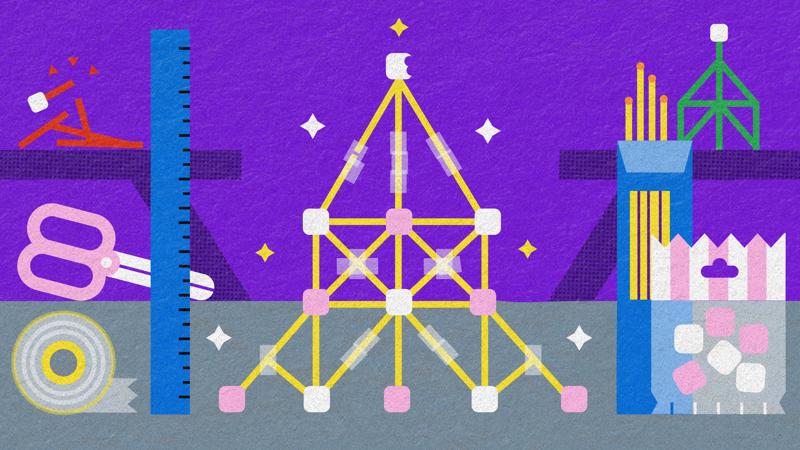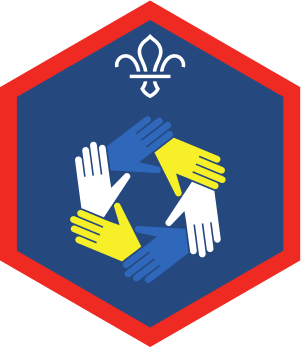
Play Equity Spaghetti
You’ll need
- Tables
- Chairs
- Scissors
- Spaghetti (10 pieces per team)
- Marshmallows (2 per team)
- Sticky tape (5 pieces per team)
Before you begin
- Use the safety checklist to help you plan and risk assess your activity. There's also more guidance to help you carry out your risk assessment, including examples.
- Make sure all young people and adults involved in the activity know how to take part safely.
- Make sure you’ll have enough adult helpers. You may need some parents and carers to help.
Planning and setting up this activity
- This activity uses marshmallows and spaghetti. Remember to check for allergies or dietary requirements, then adjust the foods you use as needed. For example, you may need to use vegan marshmallows. You may need to make sure there’s no cross-contamination during food storage, preparation, packaging or food handling too.
- Prepare green, yellow and red cards with instructions for the teams in advance.
- Assign someone as the ‘facilitator’ for this activity. This could be an adult volunteer, a young leader or a member of the group.
Running this activity
- Gather everyone together and explain that you’re going to do a spaghetti building challenge.
- Divide everyone into at least three groups and assign each one either green, red and yellow. Make sure each team has a table to work on and hand out the spaghetti, marshmallows, tape and scissors. Each team needs 10 pieces of spaghetti, 2 marshmallows, 5 pieces of sticky tape and a pair of scissors.
- Give the teams these instructions: You have 15 minutes to build the highest spaghetti tower you can. It must be placed on the table, be able to stand by itself, and support a marshmallow on top.
- When it’s time to start, hand out the cards to each team.
- The facilitator should be stood or sat near extra resources. They will have a fixed amount of extra resources they’ll give to the green team when they ask. They’ll have the same amount to hand out to the yellow team, but will only hand out what they feel like, based on the request, their reasons, and the way they ask. If the red team ask for any extra resources, they should be told that they can’t take anything.
- If team members want to speak to the facilitator, they should queue up. You could place cones or markers on the floor to remind people. The facilitator can decide whether to fast track members of the green team to the front.
- It’s not expressly said, but there’s no rule that requires teams to build separate towers. There are no rules to stop anyone sharing resources too.
- Once the 15 minutes is up, as a group everyone should review the towers and see which team managed to build the tallest.
As greens, you are entitled to additional resources for this challenge. Take this card to the facilitator who’ll provide these for you.
As yellows, you may be eligible for extra resources for this challenge. Take this card to the facilitator, along with an explanation of what you need and why you need it. The facilitator will decide whether you can have it, their decision is final.
As reds, we wish you the best of luck in this challenge. Good luck!
Reflection
This activity was all about working as a team and solving problems. How did it feel to be in the team they were in? Do they think they did a good job building the tower? Would they want to change teams?
Ask each team to share what was written on their card. Did you feel like you were treated fairly, or did you notice that some teams had an advantage? Some teams had easy access to extra resources, while others didn’t get as much help, or even any help at all. This is called differential treatment—when people or groups are treated differently based on certain factors, rather than everyone having the same opportunity. This can affect what we can accomplish.
For the green team, how did it feel knowing you could get extra resources whenever you needed? Did it make the activity feel easier?
For the yellow team, where sometimes you got extra resources and sometimes you didn’t, was it confusing or frustrating?
And for the red team, how did it feel to be told you couldn’t have any extra resources at all, no matter how politely you asked?
This activity helps us understand how differential treatment can affect people in real life. If some people or groups always get more help or better resources, they may have more success, while others may struggle without the same chances. How do you think this type of treatment might affect what people can achieve in school, sports, or even in jobs? Can you think of a time you or someone else may have been treated unfairly compared to someone else?
We should remember that sharing what we have and making opportunities equal for everyone can lead to better outcomes for all. Did anyone share or ask other teams for resources, and how might things have changed if everyone had equal access or worked together? How could we make sure that people around us are treated more equally and fairly?
Safety
All activities must be safely managed. You must complete a thorough risk assessment and take appropriate steps to reduce risk. Use the safety checklist to help you plan and risk assess your activity. Always get approval for the activity, and have suitable supervision and an InTouch process.
- Scissors
Supervise young people appropriately when they’re using scissors. Store all sharp objects securely, out of the reach of young people.
- Food
Remember to check for allergies, eating problems, fasting or dietary requirements and adjust the recipe as needed. Make sure you’ve suitable areas for storing and preparing food and avoid cross contamination of different foods. Take a look at our guidance on food safety and hygiene.
- To make this activity easier or harder, you can change the amount of resources you give each team to start to make this more or less challenging. You could also change the amount of time to build or the number of people in each team. You could also ask them to build a more complicated structure.
- If anyone struggles with fine motor skills, you could suggest working in pairs. Alternatively, swap out the spaghetti for something easier to handle – it could be breadsticks, some pens or pencils and sticky tack, or some skewers.
All Scout activities should be inclusive and accessible.



